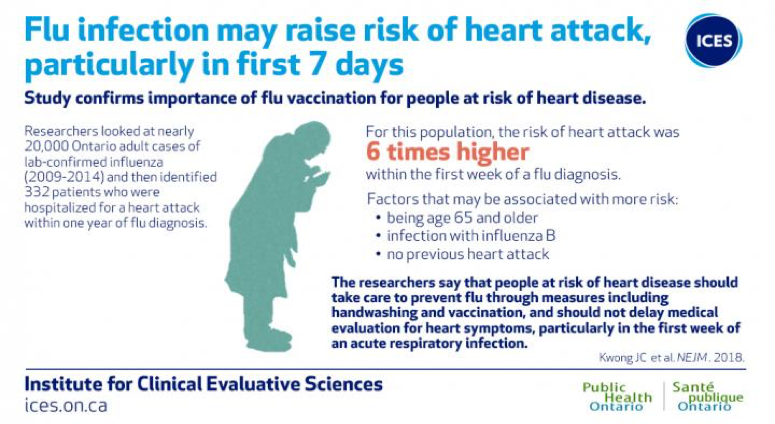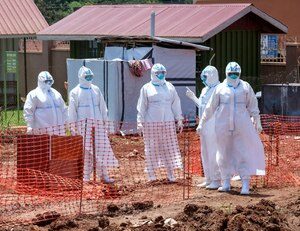Influenza (FLU) Update for Week Ending 5-4-19
For week #18 (ending 5-4-19) the CDC reported that Influenza (Flu) activity, which includes diagnosed flu as well as ILI (Influenza-Like-Illness), continued to decline during Week #18, as this year’s Flu Season repeated a decrease in almost all flu markers. Only two (2) states had widespread flu activity and ILI is again under the national baseline of 2.2%. Nine (9) out of 10 Regions reported “Normal” activity with ILI less than each of their region-specific baselines. The percentage of respiratory specimens testing positive for flu decreased to 4.7%% from 5.4% last week. The number of hospitalizations from flu continued to increase for the >65 & 50-64 age groups. Adult mortality from pneumonia and influenza was again below the epidemic threshold. Week #18 added to pediatric morality from flu with five (5) deaths. The CDC expects flu and ILI activity to continue to decline. There may still be sporadic increases in Flu/ILI markers, but the record-long 2018/19 Flu season is winding down.
Of the respiratory samples tested for Week #18, Influenza A(H3) was more prevalent nationally and dominant in seven (7) of 10 Regions, but A(H1N1)pdm09 was more dominant when considering the results of the entire Flu season in total. And, as expected in the Spring, Influenza B positives have increased over the past few weeks. Overall, Influenzas A(H1N1), A(H3N2), and Influenza B viruses were co-circulating.
FirstWatch RIN (Regional Influenza Network): RIN Alerts for Weeks #18 showed a decrease in number.
For the most recently reported week, ending May 4, 2019, the CDC reported:
Influenza-like illness (ILI) visits to clinics & other non-hospital facilities decreased to 1.6% (l. w. 1.8%), below the national baseline of 2.2%. All but one Region reported levels below their region-specific baselines, with a range of 0.9% to 2.3%; Region 8 (Western Central) was at its baseline.
Flu cases, documented by positive flu tests of respiratory specimens, were reported as Widespread in only two (2) states. Clinical lab testing for influenza was positive for 4.7% of specimens, compared to 5.4% last week, with a range of 3.4% (Region 3, Mid-Atlantic) to 10.1% (Region 1, Northeast). Only one region was in double digits.
For the reported week, Influenza A remained the dominant flu for 66% of the flu tests reported, but the rest were an increasing number of Influenza B at 34%. The H3N2 subtype remained the dominant Influenza A virus at 82.4% with A(H1N1)pdm09 viruses at 17.6%. Of the Influenza B results, Yamagata was at 16.7% and Victoria at 83.3%. Typically, Influenza B viruses occur more toward Spring and cause less severe illness. A(H3N2) viruses are known to cause increased severity and be less covered by the flu vaccine. This pattern is mirrored in much of the world.
The CDC provides an interactive U.S. map that will link to each state’s public health authorities. ILI and Flu information and processes, as well as other diseases and public health topics. This site includes a tremendous amount of information at the State and even Local level. Find it at this site: https://www.cdc.gov/flu/weekly/usmap.htm
For Influenza-Like Illness:
NO High or Moderate ILI Activity
Low Activity: (2 states): Colorado and Kentucky
Minimal Activity: (New York City, Washington D.C., Puerto Rico, U.S. Virgin Islands & 48 states): Alabama, Alaska, Arizona, Arkansas, California, Connecticut, Delaware, Florida, Georgia, Hawaii, Idaho, Illinois, Indiana, Iowa, Kansas, Louisiana, Maine, Maryland, Massachusetts, Michigan, Minnesota, Mississippi, Missouri, Montana, Nebraska, Nevada, New Hampshire, New Jersey, New Mexico, New York, North Carolina, North Dakota, Ohio, Oklahoma, Oregon, Pennsylvania, Rhode Island, South Carolina, South Dakota, Tennessee, Texas, Utah, Vermont, Virginia, Washington, West Virginia, Wisconsin and Wyoming
For Flu (positive flu tests):
Widespread Activity: (2 states): Massachusetts and New York
Regional Activity (Puerto Rico & 7 states): Arizona, Connecticut, Kentucky, Nevada, Ohio, Utah, and Washington,
Local Activity: (18 states): Colorado, Florida, Georgia, Hawaii, Louisiana, Maine, Maryland, Michigan, Minnesota, Mississippi, Montana, New Hampshire, New Mexico, North Dakota, Pennsylvania, South Carolina, Vermont, and Wisconsin
Sporadic Activity: (Washington D.C., U.S. Virgin Islands & 22 states): Alabama, Arkansas, California, Delaware, Idaho, Illinois, Indiana, Iowa, Kansas, Missouri, Nebraska, New Jersey, North Carolina, Oklahoma, Oregon, Rhode Island, South Dakota, Tennessee, Texas, Virginia, West Virginia, and Wyoming
NO Activity: (1 state): Alaska and Guam and did not report
Other Data:
The hospitalization rate from Flu continued to increase to 65.7 per 100,000 (last week 64.7/100,000), but is leveling off and increasing at a much slower pace. Older adults (age > 65 years) had the highest hospitalization rate at 221.5 per 100,000 (l.w. 216.6/ ); adults (age 50-64 years) were at 81.3 per 100,000 (l.w. 80/ ); and children (ages 0-4) had 73.6 per 100,000 (last week 74/ ).
As of 5/9/19, the death rate for pneumonia & influenza in adults was at 6.0% and below the epidemic threshold of 6.8% for week #17. Note: the epidemic threshold number may change from week to week.
There was a total of 5 pediatric deaths, attributed to flu, this week. This raised the total number of deaths, for this Flu Season, to 101.
Flu in Canada, Europe & the World:
Canada:
According to the Public Health Agency of Canada (PHAC), for Week #18, ending 5/4/19, flu activity declined, although A(H3N2) and Influenza B still circulated throughout many Regions of the country. The PHAC also reported that Influenza A(H3N2) cases represented 84% of the Influenza A subtyping this week, compared to 82% for last week. However, A(H1N1)pdm09 was still the dominant type for this Flu Season as a whole. Meanwhile, very little Influenza B has been identified this season when compared to other seasons.
Widespread Activity in 0 Regions
Localized Activity in 14 Regions: Ont. (6), Que (3), N.B. (1), N.S. (1) & N.L. (3)
Sporadic Activity in 26 Regions: B.C. (5), Sask. (3), Man. (5), Que (4), N.S. (1), N.B. (6), P.E.I. (1) & N.W.T. (1)
No Activity Reported in 5 Regions in 4 different provinces
For more specific information see:
On flu activity: https://www.canada.ca/en/public-health/services/publications/diseases-conditions/fluwatch/2018-2019/week18-april-28-may-4-2019.html
Canadian Flu Information: https://www.canada.ca/en/public-health/services/diseases/flu-influenza.html
General Page for Canadian Flu Watch Surveillance with links to different components:
https://www.canada.ca/en/public-health/services/diseases/flu-influenza/influenza-surveillance.html
Europe:
According to the European Center for Disease Prevention & Control (ECDC), for Week #1 (Apr 29 – May 5, 2019), few countries reported flu detections and, of those that did, the number found was low; only four (4) positives out of 105 specimens. All the countries reporting ILI or ARI (acute respiratory illness) reported levels at baseline, suggesting that the influenza season for Europe is coming to an end. Those reported with severe acute respiratory infection (SARI) that were tested for flu viruses, had a positive result of 6.4%; 80% of those were Influenza A. Data from 23 reporting Member States and areas that reported to the EuroMOMO project, indicated that all-cause mortality stayed at expected levels for this time of the year. For more information see: https://flunewseurope.org/
World: The World Health Organization (WHO) provides info on Influenza in Member Countries here: https://www.who.int/influenza/surveillance_monitoring/en/
First Responder Specific Information
There are many websites that may be helpful in planning and managing seasonal flu within First Responder organizations. A few of those websites are included here:
NIOSH on Flu for Employers/Employees:
https://www.cdc.gov/niosh/topics/flu/
Protection from Flu:
https://www.cdc.gov/flu/protect/habits/index.htm
Weekly Flu Map:
https://www.cdc.gov/flu/weekly/usmap.htm
World Map Showing Flu & Other Infectious Diseases:
https://www.healthmap.org/en/
Other Actions First Responders Should Consider
- First Responders should be vaccinated for Flu each season to prevent getting flu themselves, taking it home to family members, or transmitting it to patients in their care. Family members and patients may be at increased risk of complications from flu.
- Perform proper hand hygiene including frequent handwashing and the use of hand sanitizers in general, and particularly when providing patient care or after touching surfaces.
- Masks (N95 or N100) should be used in the presence of patients with cough and/or fever; preferably before being within 6 feet of the patient. This becomes even more important if droplet producing procedures are being performed (i.e. suctioning, nebulizer treatments, BVM, intubation).
- Care should be taken to avoid touching your own face and mucous membranes (eyes, mouth, nose) since the flu virus is frequently found on surfaces such as door knobs, writing & recording tools (pens and tablets), cot and equipment handles, phones, light switches, as well as clothing, bed clothes, etc.
- Report signs/symptoms of flu to your physician or other appropriate provider for early assessment and care. Alert your employer per policy.
- Cough and sneeze into your sleeve, if a tissue is not available, and not onto your hands. Watch this Youtube video for a humorous but educational approach on the subject. https://www.youtube.com/watch?v=CtnEwvUWDo0
- Stay away from others if you are sick.
- Be aware of your exposure risk and history to prevent exposing others. Take extra precautions or avoid those with immunocompromise, when possible, if you have a known or likely exposure.
- Antivirals may be indicated for the treatment of flu, particularly for those in high risk groups, those who are hospitalized or have severe, complicated or progressing flu. Those that present with 48 hours of the onset of symptoms may also be given antivirals, based on PCP judgement but make sure the practitioner is aware of their First Responder Role. See https://www.cdc.gov/flu/antivirals/whatyoushould.htm
And, for consideration when looking at yourself, your family and friends, or your patients, consider the following information regarding complications of flu:
Flu is much more worrisome for the very young and the elderly, as well as those who fit into one of the high risk categories see this link for the list: https://www.cdc.gov/flu/about/disease/high_risk.htm . Signs of ILI/Flu in this group requires careful assessment to rule out complications and these groups are much more likely to need medical oversight to assure adequate care. Young children and those over 65 are typically at greater risk for complications, hospitalization, and even death.
Consideration should be given to perhaps monitoring these groups more closely, with inclination for more comprehensive assessment and transport for further evaluation, when presented with possible flu and any signs of complications.
Complications of flu, sometimes requiring hospitalization and even leading to death, tend to occur after the person has begun to get better from the flu and then appears to relapse. EMS personnel may want to look more closely at those patients when the call is not about the initial signs and symptoms of flu, but about increasing or different signs that have appeared, often from five days to two weeks after the initial flu symptoms began.
A study was published by the Institute for Clinical Evaluative Sciences in NEJM (New England Journal of Medicine). See details below:

Image courtesy of ICES/PHO
“The researchers add that patients should not delay medical evaluation for heart symptoms particularly within the first week of an acute respiratory infection.” (Lisa Schnirring, News Editor: CIDRAP News ;Jan 25, 2018)
For more information on Influenza and the Heart Attack Study, please see the link below.
https://www.eurekalert.org/pub_releases/2018-01/pho-rcl011818.php


